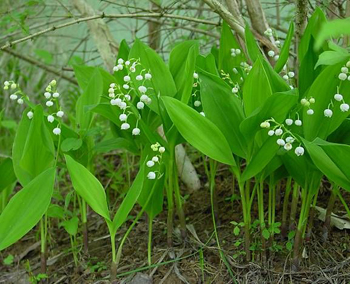Contents:
Common Names | Parts Usually Used | Plant(s) & Culture | Where Found | Medicinal Properties | Biochemical Information
Uses | Formulas or Dosages | Warning | Bibliography
Scientific Names

- Convallaria majalis L.
- Lillium convallium
- Liliaceae
- Lily family
Common Names
- Convallaria
- Conval lily
- Lily confancy
- Male lily
- May lily
- May bells
Parts Usually Used
Young leaves, roots and flowers
Back to Top
Description of Plant(s) and Culture
A perennial plant that grows in the shade and has a single pair of basal, oblong-ovate leaves entire (not toothed); veins parallel; connecting veins obvious when held to the light and a single leafless raceme of very fragrant, small, white, bell-shaped flowers. Spreading by root runners; 4-8 inches. A slender, creeping rootstock produces 2 oblong-elliptic, pointed, basal leaves up to 1 foot long. Their bases sheathe the bottom of the flower stalk, which bears at the top a one-sided raceme of white, bell-shaped flowers. Flowering time is from early spring to June. Seed is ripe in September.
The Canada mayflower is often called false lily-of-the-valley (Maianthemum canadense Desf.) It is a perennial, often forming large colonies; 3-6 inches. Leaves usually 2, base strongly cleft (heart-shaped). Tiny, 4-pointed flowers; April to July. Berries are whitish, turning pinkish; speckled. Easily distinguished from Lily of the Valley (Convallaria majalis L.), here reported on.
Back to Top
Where Found
Widely cultivated, but still found in some woodlands (escaped from cultivation)and often near old homesites, barns, yards, etc. Native to Eurasia but is commonly grown in gardens in the United States and Canada, from where is sometimes escapes into the countryside.
Back to Top
Medicinal Properties
Antispasmodic, cardiac, diuretic, emetic, laxative, tonic, mucilaginous
Back to Top
Biochemical Information
Cardiac glycosides, saponins, convallarin and convallaric acid, asparagin, cheliodonic acid and various other organic acids.
Back to Top
Uses
This pretty plant is a formidable brain, lymph, and heart herb, from which the drug convallatoxin is obtained. It has been successfully employed in treating patients recovering from strokes, especially when their speech is slow to return. It also soothes the nerves, reduces high blood pressure, helps epilepsy, dizziness, convulsions, palsy, apoplexy, and cures various forms of dropsy. It can be made into an ointment for headache, and for rheumatic, or gouty pains. Root ointment, folk remedy for burns, to prevent scar tissue. Russians use this herb for epilepsy.
It is used for nervous sensitivity, neurasthenia, apoplexy, epilepsy, dropsy, valvular heart diseases, heart pains, and quieting to heart diseases in general. This herb contains glycosides similar to digitalis but milder. Combined with sea onion, this herb is a safer more effective treatment than digitalis. Digitalis is retained in the body and over a long period of therapy may damage the heart. This combination of sea onion (Urginea maritima) is not cumulative and is gentle, and supportive of the heart muscles.
Back to Top
Formulas or Dosages
Prepare an infusion from the flowering stalks; 1/2 oz. to every pint of water. The dosage in all cases is 4 tbsp. per day in divided doses.
Back to Top
Warning
Lily of the Valley contains glycosides that act somewhat like digitalis (foxglove) and can produce irregular heartbeat and upset stomach.
Potentially toxic. Leaves can be a mild skin irritant.
Overdose or large doses can cause strong stomach and intestinal irritation. Improper administration could result in toxic effects; nausea, vomiting, and diarrhea.
Use with proper medical supervision only.
Back to Top
Bibliography
![]() The Herb Book
The Herb Book, by John Lust, Bantam Books, 666 Fifth Avenue, New York, NY. copyright 1974.
![]() Back to Eden
Back to Eden, by Jethro Kloss; Back to Eden Publishing Co., Loma Linda, CA 92354, Original copyright 1939, revised edition 1994
![]() Culpeper’s Complete Herbal & English Physician: Updated With 117 Modern Herbs
Culpeper’s Complete Herbal & English Physician: Updated With 117 Modern Herbs, by Nicholas Culpeper, Meyerbooks, publisher, PO Box 427, Glenwood, Illinois 60425, 1990, (reprint of 1814)
![]() The Complete Medicinal Herbal
The Complete Medicinal Herbal, by Penelope Ody, Dorling Kindersley, Inc, 232 Madison Avenue, New York, NY 10016, First American Edition, copyright 1993
![]() Eastern/Central Medicinal Plants
Eastern/Central Medicinal Plants, by Steven Foster and James A. Duke., Houghton Mifflin Company, 215 Park Avenue South, New York, NY 10000
![]() The Nature Doctor: A Manual of Traditional and Complementary Medicine
The Nature Doctor: A Manual of Traditional and Complementary Medicine, by Dr. H.C.A. Vogel; Keats Publishing, Inc., 27 Pine Street (Box 876) New Canaan, CT. 06840-0876. Copyright Verlag A. Vogel, Teufen (AR) Switzerland 1952, 1991
 Old Ways Rediscovered
Old Ways Rediscovered, by Clarence Meyer, Meyerbooks, publisher, PO Box 427, Glenwood, Illinois 60425, published from 1954, print 1988
![]() Planetary Herbology
Planetary Herbology, by Michael Tierra, C.A., N.D., O.M.D., Lotus Press, PO Box 325, Twin Lakes. WI 53181., Copyright 1988, published 1992
![]() American Folk Medicine
American Folk Medicine, by Clarence Meyer, Meyerbooks, publisher, PO Box 427, Glenwood, Illinois 60425, 1973
![]() Webster’s New World Dictionary
Webster’s New World Dictionary, Third College Edition, Victoria Neufeldt, Editor in Chief, New World Dictionaries: A Division of Simon & Schuster, Inc., 15 Columbus Circle, New York, NY 10023
